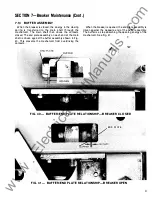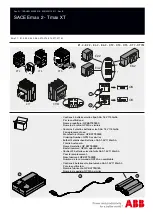
SECTION 7-Breaker Maintenance (Cont.)
The areas requiri ng l ubrication are:
1 . Contacts Pivots - A thin fi l m on the stationary
and movable contact assembly pivot surfaces. Refer
to Section 8. Do not lubricate the contact tips.
2. Racking Mechanism - The drive threa
?
s, jamb
nut/trunnion interface, thrust washer/col lar mterface,
and the shaft support beari ngs. Refer to Section
7. 1 3.
3. Manual Operating Handle - Lubricate the two pivot
areas associated with the adj ustment l i n kage. Also,
the handle, mounting shaft/support bushing inter
face. Refer to Section 7.2.
4. Flux Shifter - Lubricate pivoting and sliding sur
faces of the reset l i n kage. Refer to Section 1 0.3.
5. Switchette - Lubricate the activator lever surface
that contacts the switchette button.
6. Mechanism - All accessi ble bearing and sliding sur
faces that have been factory l ubricated.
7. Prim ary Disconnects - Lubricate the finger contact
surface j ust prior to install ing in switchgear or
l ubricate and then cover the disconnect assembly to
protect from dust, dirt, etc. Refer to Section 7.5
Before l ubricating, remove any hardened grease or d i rt
from the latch and bearing surfaces. After l ubricating,
remove all excess lubricant to stop accumulation of d i rt or
d ust. The use of cotton waste to wipe bearing surfaces
should be avoided. The cotton ravelings may become
entangled under the bearing surfaces and destroy the
surface of the bearing.
7.2 MANUAL HANDLE ADJUSTMENT
The adjustment linkage connects the handle assembly to
the chain drive mechanism which turns the cam shaft. The
length of this linkage provides the handle adjustment.
If the link is too long, the handle stroke cannot extend the
closing spring enough for it to go over center. In this event,
use the maintenance handle to complete the spring charg
ing. The breaker can then be closed and opened prepara
tory to further shortening of the link.
If the link is too short, charging is not possi ble.
The original linkage design used a double-ended stud in
the linkage center. A hex section in this stud allowed adjust
ing with an open-end wrench. When looking down on the
breaker, turning the wrench clockwise lengthens the link.
The opposite motion shor.tens it. The range of adjustment
is 300 degrees. In the confined space available, each
wrench stroke i mparts 1 5 degrees movement. The best
setting is approximately mid-range.
The present design is shown in Fig.
20.
This linkage is
assembled together on a threaded stud. Adjustment is
accomplished by removing the upper linkage assembly
from the handle assembly and changing the linkage length
by turning the upper l inkage up or down the threaded stud.
FIG. 20
-
MANUAL HANDLE ADJUSTMENT
19
www
. ElectricalPartManuals
. com





































